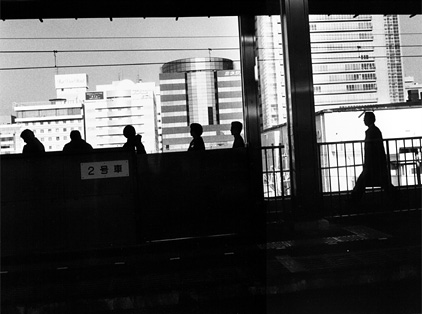 |
||
| |
 |
|
| |
|
|
| |
||
| |
||
| |
||
|
|
||||||||||||||||
An Overview by Sylvia G. Borda For this body of work I’ve examined Tokyo and London’s transportation lines. For the Japanese segment I focus on the Yamanote (green - circle) line that connects various boroughs in the heart of Tokyo. This line is popular amongst a cross-section of users and, similar to the Docklands line in London, was constructed to connect transit users from outlying areas to the heart of the city center in an effort to optimise efficiency and promote new socio-economic developments. These seemingly unlike areas share cross cultural histories undetected perhaps by site but well documented in print. During the Meiji period the Emperor commissioned English and German engineers to construct a rail system for Tokyo. Hence the past and current rail systems within Japan are based on a European model of transportation and architectural structure. Ironically the Docklands area was the first to be powered with steam engines and cranes. Shipments being deployed from this dock were often comprised of steel and iron going to the Orient. Materials that originated from Docklands during the 1880s may have become part of Japan’s transportation grids. The photographs are arranged in grids with limited labeling to identify the places from which they originate. While the grids appear to form typological systems, viewers are left to examine minute details within the image plane in order to identify location. Markers and signifiers are reduced wherever possible to limited icons so that location becomes irrelevant and the viewer consumes the image on a more immediate (and even mundane) level, similar to the rapid scanning attention of someone on a daily commute. The level of ambiguity left within the image aids in framing a discourse about social migration and supermodernist architecture where these temporary holding spaces for the working/commuter classes become universal and non-descript. Each of these concepts questions one's position within the grid of a modern transportation system and, likewise, within an urban city scheme that symbolizes a new gentrification of subcultural zones. Ironically cross cultural hybridization can reverse through history. For instance, the new Docklands rail and plazas like the 'Excel' are an indirect import from the East; the Excel complex was designed by Malyasian architects. The engineering for the Docklands rail, in fact, comes from Japanese models. All of these influences become cross-hybridized and re-hybridized at their points of origin. In this way through both the architectural form or through the physical gathering of commuters, it becomes impossible to guess form from location. Is a Japanese man waiting for a train on a British rail platform or is he in Japan? What does cross globalization mean in terms of identity, and how does global architecture, transportation alter identity? As a Canadian photographer creating works abroad I too have a relationship to the places I visit. For example, I am intrigued by the superimposition of names throughout the Docklands sites that refer to Canada Place and related Canadian iconography. My works are a reflection of social –economics; Canada Place and related buildings are direct results of a revitalization program brought to the area by the Montreal’s Bronfman family. In depicting Docklands I am not only reflecting on Japanese and British cultural cross-pollination, but on Canadian roots, as well. ** The series started in 1997 and consists of over 200 color and black and white images. Print size 11x14 inches. |
||
| © Sylvia Grace Borda 2005. All rights reserved. |









